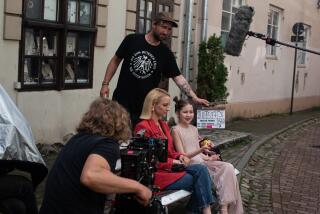Baltic States Gear Up for Free Market : East Bloc: Experts say they will need to make peace with other Soviet states that supply much of the raw material for manufacturing.
- Share via
As they did when they were free nations in the 1920s and 1930s, the once-again independent Baltic states of Lithuania, Latvia and Estonia are reaching out to the West in a bid for foreign investment and trade.
Yet if these reincarnated states are to attract Western investment, their leaders--whose political break with Moscow has been recognized internationally in recent days--must now also find a way to retain many of the economic supply lines forged by the Soviet Union over the past five decades, economists say.
“The Baltic countries integrated their economies with Western European during the previous period of independence,” noted George Viksnins, a Latvian-born Georgetown University professor. “Such re-orientation is not possible this time, because the economies are now integrated with the various Soviet republics. In the near term, they can’t change their trade and supply relationships radically.”
As elsewhere in the former East Bloc, nonetheless, Americans--many of Baltic descent--are advising the breakaway republics on how to establish market economies. And some Americans are hoping to aid their homelands directly.
Raymond Blinstrubas--or Bliss, as he calls himself in the United States--is one of 14 Lithuanian businessmen from the Chicago area who three years ago formed a corporation called IPSA, Industrial Partners Assn., in an effort to facilitate U.S. investment in Lithuania.
The investors, most of whom emigrated to the United States as teen-agers, saw the group as a way of aiding the Lithuanian independence movement and seizing on a promising business opportunity for themselves. IPSA is planning to build electronic appliances such as microwave ovens in Lithuania for sale in the Eastern European market.
“The corporation has made an agreement that profit will be reinvested in Lithuania,” Blinstrubas said Tuesday. “But the inspiration for all this is the economic opportunity. Labor rates are good. It’s not as awkward technically as, for example, (South) Korea was when it started its drive for Western investment. The conditions for business investment are good--and I think now they will become even better.”
Major U.S. companies said to be considering possible ventures in the Baltics are Chrysler Corp., Motorola and McDonald’s. Brown & Sharpe--a Providence, R.I., machine tool maker--recently launched a manufacturing venture in Lithuania.
For now, however, the Baltic economies remain tightly linked to their old oppressors. Viksnins, who has been advising the government of Latvia on how to develop a new monetary system to replace the Soviet ruble, said 50% to 60% of the Baltic states’ economic output derives from trade with the Soviet Union.
Up to now, the Baltic states--in the name of political independence--have sought to distance themselves from efforts in Moscow to reorganize the Soviet state in the wake of the collapse of the central communist authority.
But because much the raw material that feeds manufacturing in the Baltic states originates in other Soviet regions, the breakaway nations will need to make their economic peace with the remaining Soviet republics, said Michael Claudon, president of the Geonomics Institute, an economic consulting firm in Middlebury, Vt., that specializes in the Soviet economy.
“If these supply lines are maintained, there will be great Western investor interest in the Baltics,” Claudon said.
He said Western investors will be lured by “top-notch” port facilities in Latvia and Estonia. Moreover, state enterprises in the Baltic nations tend to be smaller and more manageable than the huge state enterprises of Russia and other Soviet republics, he added.
Lithuania was the Soviet Union’s high-technology center, building computers and industrial robots; Latvia has a good reputation for building motorized vehicles; Estonia has some valuable natural resources, Claudon said.
According to Viksnins, though, the Baltic countries will need to issue new currencies and enact further laws that accommodate private enterprise if they wish to attract Western business. “The economic reforms should be on fast track, but the Baltics must show that they can work with other republics,” he said.
After years of waiting for independence, however, Baltic emigres aren’t waiting for reform.
Consider the case of Norbert Klaucens.
Until 1989, Klaucens had no desire to visit his native country, much less do business there. “My father was executed in Latvia,” the Chicago businessman explained. “I came here in 1950 and I didn’t want to go back.”
But last year, Klaucens--who started an engineering and architectural firm 26 years ago--saw the political and economic changes going on in Latvia and decided to return home to test the business environment.
His firm plans to provide communications, translation and secretarial services in Latvia--in addition to leasing office space and collecting information on opportunities for industrial and agricultural investment.
“I’m sure there’ll be some competition,” Klaucens said. “But we’ll benefit from being the first kids on the block.”
George White reported from Los Angeles and Amy Harmon reported from Detroit.
Soviets look to EC model. A7
The Baltic Economies Trade between the U.S.S. R. and the newly independent Baltic states is extensive. The Baltics have relied on the Soviet Union for much of the raw materials used in their large manufacturing operations. In turn, Latvia, Lithuania and Estonia have exported finished products to other Soviet republics. With a relatively strong manufacturing base, residents of the Baltics have enjoyed a higher standard of living than most in the Soviet Union. 1. Estonia Population: 1.6 million Major Industries: oil shale mine, phosphates for fertilizer, uranium, pulp and paper products, furniture, cotton textiles; port trade and fishing Average annual income: $6,240 2. Latvia Population: 2.6 million Major Industries: telephone & radio equipment, electric motors, machine instrumentation, port trade and fishing Average annual income: $6,740 3. Lithuania Population: 3.7 million Major Industries: machine tools, durable goods such as washing machines and refrigerators, furniture, fabrics, shoes Average annual income: $5,880 Source: Plan Econ, a Washington consultant
More to Read
Sign up for Essential California
The most important California stories and recommendations in your inbox every morning.
You may occasionally receive promotional content from the Los Angeles Times.










